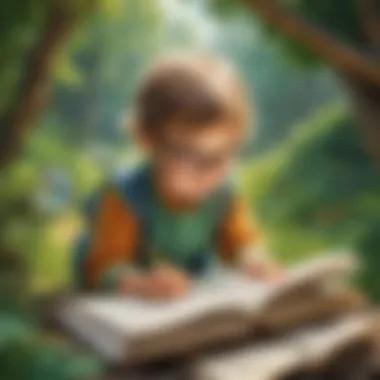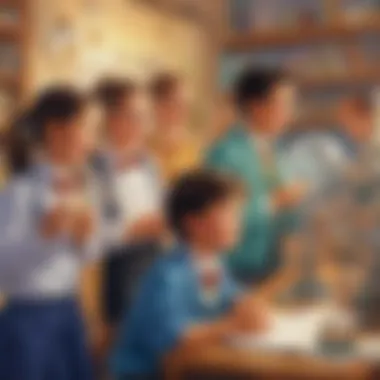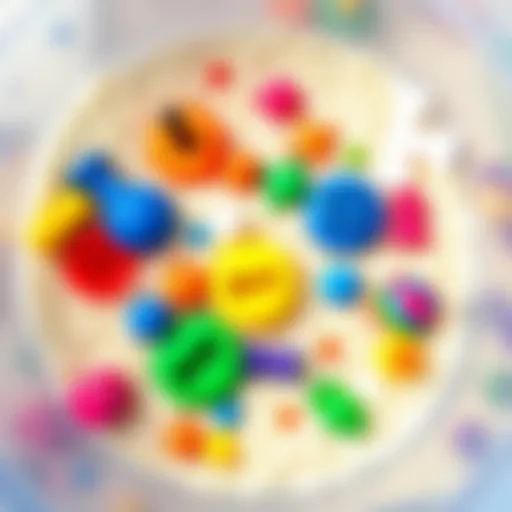Essential First Readers for Young Science Lovers


Intro
In a world buzzing with information, young minds brim with curiosity. Science, with its knack for unveiling mysteries and sparking questions, has become an alluring path for many. Yet, finding first readers that cater to this captivating world can be trickier than one might think. This guide strives to light the way, highlighting not only engaging books but also weaving in the colorful tapestry of scientific facts, interactive learning, and fun activities that nurture a child’s intellect and imagination.
By weaving storytelling with scientific inquiry, these selected titles form the bedrock of a child’s initial foray into the vast realm of knowledge. From understanding the weather to exploring the wonders of the human body, these books breed curiosity and build a solid foundation for future exploration.
Science Fun Facts
Diving into science doesn't just mean reading books; it often involves an array of fascinating snippets that can make anyone’s head spin. Here are some intriguing tidbits that might ignite a spark:
- Did you know that water can boil and freeze at the same time? This curious phenomenon is called the "triple point", where all three phases of a substance coexist.
- Honey never spoils. Archaeologists have found pots of honey in ancient Egyptian tombs that are over 3000 years old and still perfectly edible!
- A day on Venus is longer than a year on Venus. It takes about 243 Earth days for Venus to rotate once, but only 225 Earth days to orbit the sun.
"There are so many amazing mysteries waiting to be discovered. Never stop asking questions!"
Incorporating quirky tidbits into your child's learning routine can be like sprinkling a little magic dust. It turns the mundane into moments of wonder and sharpens their thinking.
Interesting Trivia and Facts
Understanding science comes with an appreciation for fun trivia. Consider sharing these facts:
- The Eiffel Tower can be 15 cm taller during the summer due to thermal expansion of metal.
- Bananas are berries, while strawberries aren't. Talk about a fruity twist!
Quirky Science Stories
Exploration often comes with its oddities. Take the tale of Sir Isaac Newton, who developed the laws of motion after a simple observation of an apple falling from a tree. This common occurrence sparked ideas that would evolve into fundamental principles of physics.
Amazing Science Records
The world hosts incredible science records that illuminate just how expansive scientific inquiry can be. For instance, the LHC (Large Hadron Collider) is the world's most powerful particle accelerator, enabling scientists to explore fundamental questions about the universe's very fabric.
Thought-Provoking Questions
Encouraging children to ponder questions can lead them on amazing discoveries. Here are a few discussion starters:
- What would happen if the sun exploded?
- How do plants know when to bloom?
Discover the Wonders of Science
As children learn, sparking their engagement with hands-on experiences can turn learning into a vibrant adventure. Here’s how to introduce them to various scientific concepts:
Exploring Various Scientific Concepts
Understanding diverse scientific topics—from astronomy to biology—helps children relate to what they see around them. Books tailored to younger audiences often break down complex ideas into digestible bits without losing the essence of the subject.
Educational Videos and Animations
Visual learning can enhance comprehension. Websites like Britannica provide diverse resources, including animations and videos that can make topics come alive.
Interactive Learning Tools
Apps and gadgets tailored for young learners can cater to their innate curiosity. Think about employing tools like science kits or simple DIY experiments to encourage daring exploration.
Real-Life Applications of Science
Connect learning to everyday life. Pointing out when a child sees weather phenomena, or when cooking at home and discussing how heat transforms food, creates pathways in their minds for deeper associations with what they read.
Science Quiz Time
Making science fun involves more than just reading. Quizzes and puzzles can fortify understanding while adding a dose of competition. Here’s how:
Interactive Quizzes


Use apps designed for younger audiences that mix challenge with rewards, ensuring endless learning could be just a tap away!
Multiple Choice Questions
Test their knowledge after reading something with some basic multiple-choice questions, maybe printed or on a whiteboard.
Brain Teasers and Puzzles
Science-based brain teasers exist that challenge kids and encourage mental agility. Where to find them? Books and educational websites have a treasure trove waiting to be cracked!
Learning Through Gamification
Kids thrive when learning feels like play. Consider activities where learning outcomes are framed around games that instill scientific concepts more engagingly.
Science Experiment Showcase
Experiments can transform theoretical knowledge into practical understanding. Here are some pointers to exciting experiments:
Fun and Engaging Experiments
Conducting simple experiments at home can be a fantastic bonding experience. Whether it’s building a volcano or growing crystals, interactive science brings facts to life.
Step-by-Step Instructions
Provide clear instructions to avoid confusion. A step-by-step format helps maintain focus and clarity during experiments.
Materials List
Before diving into any experiment, ensure that all necessary materials are gathered. This preparation can bolster the excitement and minimize distractions.
Safety Tips and Precautions
Science is about exploration, but safety should always be the priority. Preparing safety tips in an easy-to-understand format can keep young scientists safe while they discover.
Navigating the world of first readers involves more than just picking up a book. It’s about fostering an everlasting love for science and turning learning into an exciting adventure.
Prolusion to First Readers
Navigating the world of first readers can be a delightful journey for both children and adults alike. As young science enthusiasts embark on their reading adventures, the right books can light the spark of curiosity that fuels their love for learning. In this section, we will explore the significance of introducing effective first reader books, particularly those focused on science, to boys and girls who are eager to discover the wonders of the universe.
Understanding the Importance of Early Reading
When it comes to molding inquisitive minds, early reading serves as a foundational stepping stone. Studies show that children who engage with reading materials before they start school tend to develop superior cognitive skills and language comprehension. It’s like planting a seed—nurture it, and you’ll see it grow into a sturdy, flourishing plant.
Reading also enhances a child’s ability to process information. For instance, exploring basic scientific concepts through beginner books allows them to grasp ideas like gravity, ecosystems, or the weather early on. When children experience these ideas through stories, they start to connect with the world around them, making abstract ideas much more tangible. This way, curiosity is not just encouraged; it's cultivated, setting the stage for a lifelong passion for science.
In addition to cognitive growth, reading together can strengthen bonds between parents, caregivers, and kids. Simply sitting together with a book, sharing opinions, or asking questions about the content fosters a sense of connection. Plus, this shared experience transforms reading from a solitary activity into a communal adventure.
Characteristics of Effective First Readers
Selecting the right first readers involves understanding several key characteristics that make books both enjoyable and educational for young children. Effective first readers should be engaging, age-appropriate, and challenging enough to encourage learning without overwhelming the child. Here are some essential traits to look for:
- Simplicity and Clarity: The language used should be straightforward. Sentences need to flow naturally, allowing kids to focus on the story, rather than getting stymied by complex vocabulary.
- Relatable Themes: Titles that resonate with a child’s everyday experiences, such as seasons, animals, or basic physics, often capture interest quicker. When the content connects to their lives, children are more likely to engage with it.
- Visual Appeal: Illustrated content is critical. Bright, colorful images not only grab attention but can also help in deciphering difficult concepts, acting as visual aids that make learning more enjoyable.
"Books are a uniquely portable magic." - Stephen King
- Interactive Elements: Some first readers encourage interaction, such as questions or prompts for discussion throughout the story.
By keeping these characteristics in mind, caregivers can select books that will nurture a child’s passion for science while also building a strong reading foundation. Ultimately, the right first reader acts as a bridge, connecting children to the marvels of science and inviting them into a world of knowledge.
Criteria for Selection
When it comes to choosing first readers for young science enthusiasts, the selection criteria hold great weight. These budding scientists need literature that fuels their minds and expands their understanding. It’s essential to pick books that aren't just interesting but are also aligned with their developmental stage and cognitive level. Here are some crucial aspects to consider:


- Age Appropriateness and Content Suitability: Books must match the child's reading level, yet stretch their ability just enough to avoid frustration. Topics should resonate with what children are naturally curious about, like animals, planets, or the human body.
- Engagement Techniques in Narrative Structure: The way a story unfolds can make a world of difference. Engaging narratives often use cliffhangers, humor, or dialogue that resonates with the young reader’s experiences, keeping their attention glued to the pages.
- Visual Engagement: The Role of Illustrations: Vibrant illustrations are not merely decorative; they play an educational role. They can provide context, explain concepts, or stimulate creativity, which helps children to comprehend complex ideas in a digestible manner.
By thoughtfully weighing these considerations, parents and educators can help cultivate an early love of reading while also enriching scientific understanding.
Age Appropriateness and Content Suitability
Selecting books that are age-appropriate is vital in nurturing a child's reading habits. For early learners, books should feature straightforward language with manageable sentence structures. This encourages children to read independently without becoming overwhelmed. Titles with themes that tap into their existing interests, such as planets for a future astronaut or insects for a budding entomologist, can make the reading experience relatable and enjoyable.
Moreover, content suitability should not be taken lightly. Science books for young readers should strike a delicate balance between educational and entertaining. They should inspire curiosity instead of boring them with jargon or overly scientific terms. By including real-life applications or fun facts about the scientific world, children become more engaged, allowing their innate curiosity to flourish.
Engagement Techniques in Narrative Structure
Narrative structure has a profound impact on children's reading experiences. Well-structured stories keep young minds engaged and eager to discover what comes next. Techniques like foreshadowing can create suspense; maybe they'll want to turn the page to find out how a caterpillar transforms into a butterfly. Breaks in the narrative, such as questions or fun activities, can stimulate a reader's critical thinking. Incorporating characters who face relatable challenges in science can also entice young learners. By relating theories to personalities they admire or see themselves in, children are more likely to connect with the concepts being taught.
Visual Engagement: The Role of Illustrations
Don’t underestimate the power of visuals. In the realm of early science readers, illustrations can be as educational as words. They can clarify complex ideas, depict processes, or simply make the page more inviting. A well-illustrated book can capture a child’s imagination, pulling them into scenes that facilitate understanding. For instance, colorful diagrams explaining the water cycle can replace dense text, enhancing comprehension.
Additionally, illustrations can also represent diverse scenarios, be it a child in a lab coat or astronauts exploring space, fostering an environment where children see themselves as active participants in science. Illustrations serve not just as visual enhancements, but as critical components in the learning journey, embodying the essence of wonder that science holds.
Popular First Readers for Science Enthusiasts
Exploring the realm of first readers specifically tailored for young science lovers is not just about finding books with pretty pictures or engaging stories. It's about connecting children to the wonders of science in a way that fires up their imagination while providing solid educational value. Having access to well-curated selections can make all the difference in nurturing a child's curiosity and love for the natural world.
Science-Themed Titles
Exploration of Nature
Delving into the Exploration of Nature reveals a treasure trove of knowledge that stirs curiosity about the outdoors. This title is noteworthy because it emphasizes hands-on experiences, encouraging kids to observe the world around them. It connects readers to the beauty of ecosystems and biodiversity, instilling a sense of stewardship for the environment.
A key characteristic of this book is its vivid imagery, combined with engaging narratives that draw children into real-world explorations. This pertinently keeps them entertained while they absorb essential concepts about flora and fauna. One unique feature is the book's activity suggestions, giving kids opportunities to go outside, venture into their backyards, and make personal discoveries. The downside might be that not all children have immediate access to nature, limiting their ability to engage fully with the content.
The Physics of Everyday Life
Moving on to The Physics of Everyday Life, this book makes physics relatable to young readers by connecting everyday occurrences to scientific principles. The highlights of this title include clear explanations that demystify complex concepts. It does an excellent job of demonstrating how physics is in everything we do, from throwing a ball to riding a bike.
The best aspect of this book is its practical approach; children can perform simple experiments right at home, linking theory to practice. An advantage of this title lies in the way it frames physics as a natural part of daily life, rather than a series of abstract concepts. However, it may involve equipment that some families do not have readily available, potentially limiting some of the activities.
Chemistry in the Kitchen
With Chemistry in the Kitchen, readers dive into the fun world of culinary science. This book draws connections between cooking and chemical reactions, making it both fun and educational. It's unique because it takes an everyday activity—cooking—and transforms it into a hands-on science experiment. Each section stands out with easy-to-follow recipes that incorporate simple scientific principles, allowing kids to see chemistry in action.
A significant strength of this title is its ability to engage young readers by allowing them to participate directly in their learning. They create snacks while gaining insights into the chemical processes behind cooking. On the flip side, it requires adult supervision and kitchen resources, which not all families may find ideal.
Biographies of Notable Scientists
Marie Curie: A Pioneer of Radioactivity
When young readers learn about Marie Curie: A Pioneer of Radioactivity, they not only discover her ground-breaking research but also gain insight into perseverance and resilience. Her story is inspiring and showcases how she broke barriers in a male-dominated field. The book highlights her struggles and triumphs in her scientific pursuits, encouraging readers, especially young girls, to engage in STEM fields.
One of the strongest aspects of this biography is its ability to humanize a hero in science. It discusses her personal life, illustrating her as a determined individual who valued her work deeply. The drawback, though, may be that some of the scientific concepts could be difficult for younger kids to grasp, requiring adult involvement to help explain more complex topics.
Albert Einstein: The Man Who Changed Physics
The book Albert Einstein: The Man Who Changed Physics captures the essence of a name synonymous with brilliance. It places the narrative focus on Einstein's innovative thinking and methodical approach, making science seem accessible rather than intimidating. This biography inspires young minds to believe in their ability to achieve greatness.
Its engaging storytelling showcases his unconventional lifestyle and thought processes, which invites readers to appreciate the importance of creativity in science. A potential downside could be the diversion of focus from his scientific discoveries to personal anecdotes, possibly leaving some readers wanting more scientific detail.
Jane Goodall: The Life of a Primatologist
Jane Goodall: The Life of a Primatologist offers an engaging overview of a woman whose work has had a monumental impact on primatology and conservation. This biography for young readers emphasizes observational research and the connections between humans and animals. The easy-going language paired with colorful illustrations makes it perfect for capturing a child's attention.
The book's key feature is its vibrant narrative that doesn't shy away from tackling important themes of conservation and empathy toward animals. It can motivate kids to care about wildlife and their environments. A drawback might be that some elements may need further exploration or discussion to deepen young readers' understanding of ecology and conservation efforts.


Integrating Reading with Experiential Learning
In today's fast-paced world, where stimulation often takes center stage, integrating reading with experiential learning has become not just a novel idea, but a necessity. When young minds dive into a story about science, the connection becomes electric when they can translate that knowledge into hands-on activities. This becomes a dual-channel for learning—reading sparks curiosity, while actions reinforce understanding.
Combining reading with practical experiences creates a multilayered approach that enhances retention and deepens comprehension. It’s akin to giving students a map and a tour guide; they don't just read about a place—they experience it, feel it, and most importantly, understand it.
One major benefit is that it cultivates a more profound interest in science. As kids engage with the material actively, they often ask deeper, more meaningful questions. This hands-on aspect encourages them to see science as an everyday part of life rather than a mere subject found within the confines of a textbook. Plus, integrating these two elements effectively addresses different learning styles. Whether a child learns best through visual aids or kinesthetic activities, this approach can cater to all kinds of learners.
"Reading about dinosaurs in a book is fascinating, but digging up 'fossils' in the backyard gives kids a taste of archaeology. It all clicks into place!"
Hands-On Science Activities Linked to Reading
Linking science activities to the texts students are reading transforms how young learners absorb information. For instance, if a child reads about ecosystems, they could create a small garden at home to observe plants and insects in action. This hands-on activity not only reinforces what they gleaned from the narrative but also instills a sense of responsibility and ownership over their learning.
Here are a few examples of hands-on activities:
- Conducting Simple Experiments: After reading about chemical reactions in a book, children can mix vinegar and baking soda to see the fizz for themselves.
- Nature Walks: If a book discusses local flora and fauna, take a walk in the park and identify what plants or animals are around.
- Building Projects: When exploring physics concepts, kids can construct simple machines from household items, allowing them to visualize concepts like leverage or balance in real-time.
These activities foster a natural curiosity and can turn a quiet reading nook into a bustling hub of exploration.
Creating a Reading-Friendly Learning Environment
Creating a space conducive to reading is pivotal for young learners, especially when science is at play. A reading-friendly environment strikes a perfect balance between comfort and stimulation, encouraging children to settle in with a good book.
To make a reading nook effective:
- Comfort First: Bean bags, cushions, or even a cozy blanket can make a space inviting. Children should feel comfy while they're on their educational journeys.
- Accessibility of Books: Ensure that science-themed books are within reach. Organizing them by topic can help kids find items of interest without frustration.
- Visual Stimuli: Adorn the space with posters or visuals related to scientific themes, stimulating their minds with images and information that complement their reading.
- Quiet Zones: A low-stimulation area minimizes distractions, allowing kids to focus wholly on their reading.
In summary, merging reading with experiential learning is not just an enhancement—it's about enriching a child's educational path. Parents and caregivers can foster a lifelong love of reading which in turn creates budding scientists eager to explore the world beyond their pages.
Evaluating Reader Progress
In the journey of nurturing young science enthusiasts, evaluating reader progress stands as a crucial checkpoint. It's not just about flipping through pages; it’s about understanding how well children grasp the material and fostering their love for exploration. Recognizing each child's individual development helps tailor an approach that suits their unique learning styles. This process encourages readers to develop skills they need to navigate scientific concepts. The right evaluation strategies can illuminate comprehension levels, spark curiosity, and instill confidence, creating a positive feedback loop for future learning.
Assessing Comprehension Skills
Assessing comprehension skills is not a one-size-fits-all affair. It requires a nuanced approach tailored to each young reader’s abilities. One effective method is to engage in informal discussions about the content just read. Asking open-ended questions allows children to express understanding in their terms, providing insight into their thought processes. For instance, after reading a passage about the water cycle, one might ask, "What do you think happens to the water when it rains?" This encourages learners to connect the dots based on their understanding of the material.
Additionally, utilizing simple comprehension checks such as story mapping can be quite effective.
- Character, Setting, and Events: Ask readers to identify these elements, helping them analyze the structure of the narrative.
- Main Idea: Challenge them with a question like, "What was the most important thing you learned in this book?" which helps draw focus to the essence of the read.
By capturing how children interpret and internalize the material, we not only gauge their comprehension but also open the door for deeper inquiry into scientific concepts.
Encouraging Critical Thinking through Questions
Asking questions is like opening Pandora’s box of curiosity. It drives kids to think critically about what they read. Simple yet thought-provoking inquiries can spur deeper engagement with the material. Instead of just recalling facts, encourage your young readers to think beyond the lines. Questions such as "What would happen if we didn't recycle? Why do you think plants need sunlight?" invite them to explore possibilities and consequences.
Furthermore, integrating activities that stimulate critical thinking alongside reading materials is beneficial. For example:
- Science Experiments: After reading, let them test their theories with hands-on experiments. It makes reading much more interactive and meaningful.
- Draw Connections: Ask them to relate stories to their own experiences or current events, such as environmental issues they may have encountered.
The key is to transform reading from a solitary activity to an interactive adventure that ignites passion for learning.
Culmination
In today's fast-paced world, fostering a love of reading, especially in subjects like science, shapes young minds in lasting ways. This guide has aimed to illuminate the essential role that first readers play in the intellectual development of young science enthusiasts.
The Lasting Impact of First Readers on Young Minds
First readers do more than just tell a story; they plant the seeds of curiosity and encourage questions. When children engage with science-themed literature, they begin to grasp complex concepts through relatable narratives that resonate with their everyday experiences. By connecting scientific ideas to their personal world, these books turn learning into an adventure rather than a chore.
- Curiosity Stimulation: Young children naturally possess an inquiring mind. The right books can nurture this impulse, providing them with stories that encourage exploration. Each page turned can spark a new question, transforming the reading experience into a dialogue between the child and the world around them.
- Cognitive Development: Reading helps build vocabulary and comprehension, foundational skills necessary for learning. As children decode words and understand context, they improve critical thinking skills, vital in the scientific method.
- Lifelong Learning Patterns: Early exposure to engaging science literature creates a habit of inquiry. Children who develop a passion for reading at a young age are more likely to carry that love forward into adulthood. They may seek out more complex texts, deciding to delve deeper into science and other subjects as they grow.
- Enhanced Empathy: Through biographies and stories about scientists, kids learn about diverse experiences in science, developing empathy and respect toward different perspectives. They begin to appreciate the necessity of teamwork and collaboration in scientific fields.
In summary, the importance of first readers in shaping young science enthusiasts extends far beyond mere literacy. They act as catalysts for intellectual growth, curiosity, and empathy, equipping children with tools that aid in both personal and academic development. Providing the right first readers can pave the way for a future filled with inquisitive minds ready to tackle the wonders of the universe.
As children engage with science books, their minds open to vast possibilities, fostering creativity and critical thinking, essential ingredients in the recipe for success.
In this way, first readers lay a sturdy foundation for future exploration and learning, influencing the trajectory of their intellectual journey for years to come.







